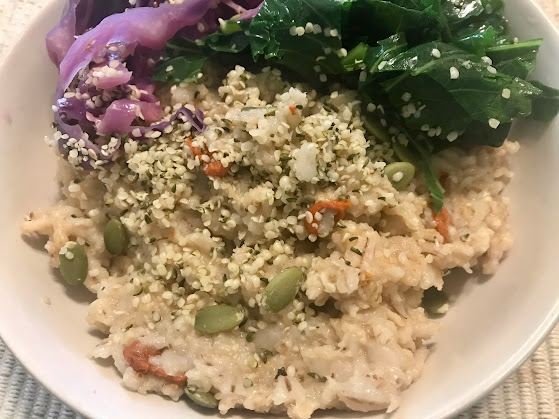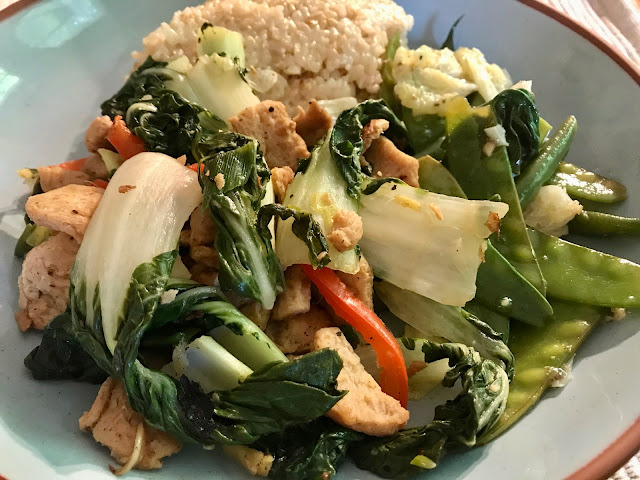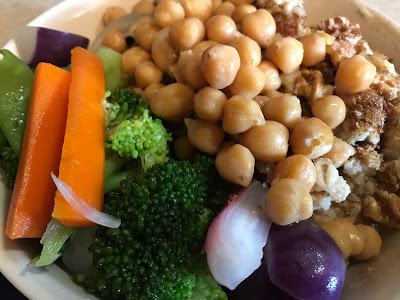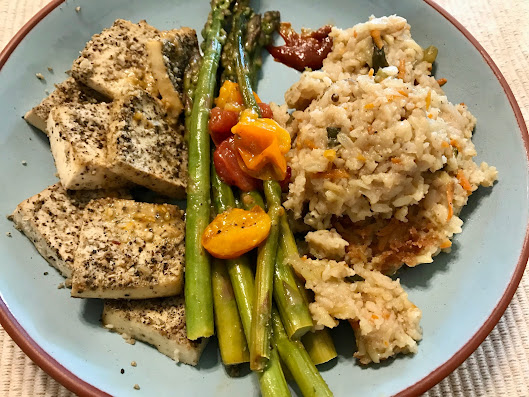How To Minimize Gas And Bloating - Recent Meals With Our Vata Reducing Dietary Revisions
In this post, I share how to minimize gas and bloating with several of our Vata reducing dietary revisions. When Don and I were previously following a vegan macrobiotic / whole-foods, plant-based diet, a main complaint was ongoing gas, bloating, abdominal pain, and irregular elimination which for me also included constipation.
In this post I share recommendations for a Vata pacifying diet used in Ayurvedic medicine to minimize gas and bloating and improve digestion, along with a summary of our recent dietary revisions, and how they have helped.
There is a plethora of dietary information circulating claiming that the very foods for which pure vegetarian / macrobiotic or vegan, whole-foods, plant-based diets are founded upon ~ whole or minimally refined natural plant foods ~ contain 'anti-nutrients,' such as phytates, lectins, fiber, gluten and oxalates, believed to be the cause of many people's digestive disorders, food sensitivities, or other health woes.
The arguments seemed convincing, so we, too, experimented with eliminating many of these healthy, life promoting foods from our diet. Thankfully, as I wrote in my article, Returning Home to our Hearts, we eventually cut animal foods back out of our diet, including dairy, and gradually reimplemented a vegan, mostly whole foods, plant-based diet. This time, however, we have made some simple Vata reducing dietary revisions to minimize the gas and bloating which had been resurfacing.
Rather than just blame the foods, we were (and continue to be) determined to heal our gut instead.
 |
| Hot Cereal made w/ a blend of Bob's Red Mill Kamut, Cream of Brown Rice & Oat Bran cereals, cooked in water w/ part Soy Milk; topped w/ hemp seeds which in Chinese food therapy are useful for moistening dryness to treat constipation. Served w/ Edamame & Green Beans tossed with Lemon Pepper & a little High Lignan Flax Oil + TerraSoul Nutritional Yeast |
As we continue our studies in Taoist Five Elements and Chinese and Ayurvedic medicine, we have been synthesizing the wisdom from these tried and true, ancient natural sciences, with a macrobiotic dietary approach. Despite our love of macrobiotics, we found some needed insights from Ayurvedic medicine. This is a work in progress, however, so far, we have had great results.
Be sure to look for upcoming posts about the foundational principles to a macrobiotic dietary approach ~ the Universal Principles of Balance and Yin / Yang Theory ~ from the perspective of its root teachings and practice in Chinese medicine.
I will also separately discuss the condition of constipation ~ an issue plaguing millions of Americans ~ in greater detail. Digestive issues have emotional roots. Chinese and Ayurvedic medicine provides answers typically lacking in Western nutritional approaches.
 |
| Very easy to digest Breakfast of Soothing Miso Soup w/ Tofu (a great legume for Vata's), Celery, Carrots, Seaweed, Ginger & a Touch of Tahini & Beet Stock (saved from boiling beets) |
Vata Dosha Disorders
In Ayurvedic medicine, gas and bloating is a Vata related disorder. While any of the three main doshas can have constipation, Vata is associated with the elements of air and ether (wind) and is rooted in the gut, hence, gas and bloating are most commonly related to a Vata dosha imbalance.
According to Dr. David Frawley, "Vata dosha is the most disease-causing of the three Doshas or biological humors of Vata, Pitta and Kapha. It represents the air element that tends to disturb us, unground us and remove us from the heavier elements that sustain our physical existence. Pitta dosha as fire and Kapha dosha as water are more stabilizing forces, though each has its own disease tendencies. Vata types are usually thin, hypersensitive, nervous and anxious. Yet we all have our times in this stressful world when Vata's instability affects us and makes us vulnerable to both physical and psychological disease factors, including weak immunity and poor resilience."
Each person will need to make adjustments specific to their predominant dosha, however, since gas and bloating is considered a Vata excess disorder, Vata reducing dietary revisions to minimize gas and bloating can be somewhat universally applied.
Frawley continues, "At physical levels, we suffer from irregular digestion, poor elimination, dry skin, allergies, arthritis, low immune function, exhaustion and debility, which all relate to Vata dosha."
Vata Reducing Dietary Revisions to Minimize Gas and Bloating
 |
| Macrobiotic Style Quick Blanched Veggies w/ a longer stem, Baby Bok Choy, Snow Pea & Asian Spinach ~ Tossed w/ a Light Umeboshi Vinaigrette when serving, extra left plain for the next day |
In Ayurvedic Healing, A Comprehensive Guide, Dr. Frawley suggests simple and moderate meals as a general treatment of gas and bloating. This means not eating too much or too frequently, nor combining too many foods at each meal. Sweet foods should be consumed on their own, and in moderation. Spicy, carminative or gas-dispelling herbs such as cardamom, fennel, ginger, peppermint, orange peel, bay leaves and most cooking spices, including several common kitchen herbs used in Italian cooking such as basil and oregano should be used when preparing meals.
Generally speaking, Vata types, like Don and myself, do best with warm, mostly cooked foods that are heavy, moistening and strengthening. The flavors emphasized are sweet, sour and salty, with less of the bitter, pungent, and astringent foods. However, when dealing with trying to minimize gas and bloating, pungent, or spicy herbs may be beneficial, as long as one minimizes consumption of pungent foods.
 |
| A Quick Snack ~ Sourdough Lightly Baked, Topped w/ Avocado, Tomato, Arugula A Squeeze of Lemon & A Drizzle of Olive Oil + Dried Oregano & Lemon Pepper |
Meals for Vata's should be small and frequent, eaten at consistent, regular meal times. Care should be taken to avoid eating while stressed or distracted. Vata types also tend to suffer more from food sensitivities, including to foods that would otherwise be good for their dosha type. Examples include potatoes, tomatoes, eggplant, peppers, chilies.
Macrobiotic teachings recommends minimizing or avoiding, depending upon one's health condition potatoes, tomatoes, peppers, eggplant and a few other 'night shade' plants as well.
 |
| Baked Potatoes may not be on the top of the list of ideal foods for Vata's, nor are they included much in many Macrobiotic circles, however, sometimes they just really hit the spot. Potassium-Rich Russet w/ Avocado, a Drizzle of High Lignan Flax Oil & Nutritional Yeast + QB Green Beans & Snow Peas ~ A perfect light lunch |
Minimizing Beans and Cabbage Family Vegetables
The key Vata reducing dietary revision we made was to greatly reduce our bean consumption.
You may wonder why this would be necessary!
Most beans are very astringent. The astringent taste causes a constriction, and drying sensation in the mouth. As the Vata nature is already dry, foods with an astringent taste exacerbates the dryness. If you've ever had a dry taste in the mouth after drinking red wine, you've experienced the astringent effect of the tannins in the wine.
Don and I were regularly consuming meals with 1+ cups of lentils or beans, mostly prepared without added fats. Initially, the high fiber content seemed to help keep the pipes flowing, but sure enough, this led to some serious intestinal distress with a lot of gas and bloating. And, ironically, dryer, lumpier stools!
Vegetables have a light nature. To minimize gas and bloating, Ayurvedic medicine recommends Vata types to prepare vegetables with oils and spices, consuming them along with whole grains for the best balance.
Raw vegetables should be kept minimal, especially during colder months. Salads can be small, and ideally prepared with oily dressings.
Generally speaking, it's not recommended to consume a large quantity of oils. While I don't think they need to be strictly avoided, as many in the whole-foods, plant-based circles, however, the dose makes the poison. The quantity tolerable will vary from individual to individual depending upon one's condition.
These recommendations more or less align with the basic macrobiotic dietary recommendations to center the diet around whole grains and lightly cooked, seasonal vegetables, with smaller proportion of beans and legumes, or raw foods.
Additional recommendations in Ayurvedic medicine to minimize gas and bloating is to minimize vegetables from the cabbage family of plants, including a variety of cabbages, broccoli, cauliflower, Brussels sprouts, kale and kohlrabi. In general, the cabbage family of vegetables can cause gas, and should be kept to a minimum until greater gut health is restored.
 |
| Breakfast Oatmeal + Barley w/ Goji Berries, served w/ Quick Blanched/Boiled, or QB Collards + Red Cabbage, Topped w/ Hemp + Pumpkin Seeds ~ A typical Macrobiotic breakfast of grains + greens or vegetables |
A Few More Vata Reducing Dietary Recommendations to Minimize Gas & Bloating
Mushrooms are diuretic and drying, which can also aggravate Vata.
Onions should be cooked, and not consumed raw.
Don and I were consuming a lot of the Vata aggravating foods, especially beans, mushrooms, kale and cabbage. So, we decided to try avoiding these foods for a while to see how we feel.
The beans best tolerated by Vatas ~ and that we have found work best for us ~ are the smaller beans, including mung and aduki beans, lentils, especially red lentils and the small brown lentils, along with split peas, and products made from soy beans, and chickpeas. Don and I were really having some gassy issues with pinto beans, black beans and kidney beans.
Since beans are drying, they can also cause constipation, despite their high fiber content, which was my experience. Tofu is actually one of the best bean products for Vata's.
When preparing beans, Vatas should cook them adequately using spices which reduce, or pacify the excess Vata, wind-causing gas and bloating. Spices which help minimize gas and bloating include hing (asafoetida, somewhat similar to garlic), cumin, ginger, and cayenne. Adding a little healthy fat can also help counterbalance the drying, astringent taste of beans.
Vata's do well with most whole grains as they are considered heavy and nourishing. According to Frawley, "Following a long-term whole grain diet can alleviate many Vata diseases." Lately, we've been cooking brown rice with 3 parts rice, 1 part mung beans, as shown, below.
 |
| Brown Rice Pressure Cooked w/ Mung Beans (About 3:1 ratio of rice:beans) Cooking in a heat proof bowl, inside of the pressure cooker helps minimize clean up. It looks like more beans than it is, because they float up to the top. I add a small piece of kelp/kombu & a few thin slices of ginger before cooking to improve digestion |
As mentioned previously, whole grains are a principal staple food of macrobiotic diets, and traditional diets from cultures around the world, as noted by Dr. Rudolph Ballentine in his book, Diet & Nutrition.
Whole grains which have a more diuretic, drying effect include corn, barley and rye, which should be consumed less frequently to minimize gas and bloating for Vata types, unless there are damp conditions (like edema, or excess phlegm) present.
Generally speaking, dry grain products should be avoided. Granola, and yeasted breads and other baked bread products should be kept minimal or avoided. Millet and buckwheat may aggravate Vata as well. I personally have found millet to be best when prepared in combination with oats for better balance, or cooked with onions and carrots or other more moistening ingredients.
Since oils are moist and warm, they are, according to Frawley, considered the "main substance for lowering high Vata because it possesses the opposite properties." That said, oils may be difficult to digest for some, in which case they can also be applied externally to be absorbed directly into the skin. Sesame oil and ghee are considered the best choices for Vatas, along with avocado, flaxseed, olive, coconut, almond, and peanut oils. We also use small quantities of high oleic sunflower oil, as it's a native oil, higher in monosaturated fatty acids than olive oil.
(For those concerned about seed oils being inflammatory, I highly recommend watching this video by Dr. Gil Carvalho of Nutrition Made Simple on YouTube.)
And finally, fruits are generally well tolerated, except dried fruits and raw apples should be kept minimal. Dried fruits can be soaked to rehydrate before consuming. Apples are best enjoyed baked or cooked.
Summary of Our Vata Reducing Dietary Revisions To Resolve Gas & Bloating
In summary, the Vata reducing dietary revisions Don and I implemented to minimize gas and bloating focused primarily on:
- Reducing total bean consumption
- Swapping out the pinto, black and kidney beans for more mung beans and lentils
- Increased consumption of soy foods, including some occasional use of plant-based sausages and meat alternatives, along with soy curls and TVP
- Increased use of spices when cooking foods
- Slight increased consumption of fats, including avocados, seeds, and some oils used when cooking, especially beans, greens and vegetables, and on salads
- Reduction in cabbage family vegetables, including kale
- Balancing any of the Vata aggravating foods consumed within the context of the total diet, with attention to preparation methods
- An increase in more 'processed' foods, including sourdough bread and pastas, and the plant-based alternative meats, mentioned above
While some of our Vata reducing dietary revisions may run counter-intuitive to what many whole-food, plant-based purists may propose, they can have a place within the context of a mindfully planned diet. We recommend adjusting according to personal health needs. As is often said, "Don't let the perfect be the enemy of the good."
These Vata reducing dietary revisions have been helpful for greatly reducing gas and bloating for both Don and I. I have shown several recent meals, including some we had been consuming prior to making our Vata reducing dietary revisions. These photos were included to show which meals were not working! (At least for now!)
Here's a video of our recent meals, with some special characters we met recently at the end.
We continue to adjust our diet to best match the macrobiotic dietary approaches which help us feel our best. Hence, some of the above revisions have been helpful short term, however, the amount of oils, and some of the vegetables and foods we have been recently consuming ~ or avoiding ~ will likely adjust as we continue to improve our health and vitality having eliminated dairy and animal foods from our diet.
The better we feel, the more we desire whole grains, especially brown rice, and vegetables as the central feature to many of our meals. And, simultaneously, adventuring into new domains to include foods, or cooking styles that were not part of our regular lexicon has been enjoyable as well.
Stay tuned, as our dietary adventures continue, and we dive deeper back into our earliest inspirations found in the macrobiotic movement, and the greater shared vision of a more peaceful world that can come about when we eat and live in harmony with the Divine Order of the Universe.
PLEASE NOTE: I have included a links throughout the text for a few products that I use, which are the brands I most prefer for their taste and quality, such as TerraSoul Goji Berries & Nutritional Yeast Flakes, and Flora High Lignan Flax Oil; I also have included links to several books below for those who would like to read more about Ayurvedic or Macrobiotic Diets. Look for more to come. Any purchases made through my links provides a small commission to me and is greatly appreciated!!!









Comments
Post a Comment
Let me know what you think! I'd love to hear from you!